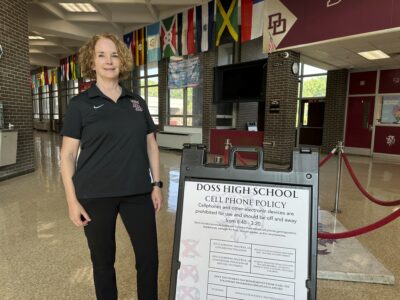That Terrible Day
On Friday, May 31, 1985, tornadoes ripped through the area, leaving death and devastation in their paths.
Homes were destroyed, forests ripped apart and ten people in Forest County and Kane were killed.
“In less than six hours,” a December report recapping 1985 in the Times Observer read, “the tornadoes killed seven people in Forest county and three in Kane. A Warren County woman, Donna Nickerson of Columbus, survived being blown 600 feet through the air while clinging to her two-year-old daughter Amy. The Allegheny National Forest lost an estimated $10 million worth of timber; and those effects were just the most obvious ones of the storms that packed 300-miles-per-hour winds, killed 65 Pennsylvanians, and sparked a massive public and private relief and restoration effort.”
It was reported in the Times Observer that at least 150 homes in Forest County were damaged. In some places, the damage was reported to be a mile wide.
Communications were “almost impossible” in Forest County due to the loss of power, telephones and radio towers.
Sight-seers to the area wanting to see the damage for themselves slowed restoration attempts. Food and clothing donation sites were established.
At 4 p.m. that day, National Weather Service radar showed a severe storm cell forming and, 20 minutes later, the advisory was elevated to a tornado watch. When the first tornado touched down at 5:05 p.m. two miles west of the Pennsylvania state line, a full-fledged tornado warning was issued.
In “Killer Tornados,” (sic) a publication distributed by Area Price Shopper that year, witnesses said they saw the funnel split into two, spawning another tornado.
Erie news stations showed unedited video, chronicling the destruction in Albion.
The storms that ripped through Tionesta went on for 30 miles to north of Marienville spanning a mile wide. Another traveled from two miles west of Tidioute to three miles south west of Cherry Grove through the Allegheny National Forest, also spanning a mile in diameter. The funnel that hit Kane started five miles southeast of Sheffield, moving to Elk State Park-26 miles-and reached two miles in diameter.
According to the National Oceanic and Atmospheric Administration, on the Fujita scale, an F-3 storm has winds that span from 158 to 206 miles per hour,and causing “severe damage.” Roofs and some walls can be torn off well-constructed homes, trains can be overturned, most trees uprooted, and heavy cars can be lifted off the ground and thrown.”
In an F-4 storm, wind speeds escalate to 207 to 260 miles per hour, causing “devastating damage.” Well-constructed houses are leveled, structures with weak foundations can be “blown away some distance,” cars are thrown and “large missiles generated.”
While no F-5 tornadoes (winds of 261 to 318 miles per hour and “incredible damage” with “incredible phenomena”) were recorded in Pennsylvania that day, the tornadoes in Tionesta and Kane were categorized as F-4 storms. The tornado that struck Tidioute was an F-3.
In total, dozens of tornadoes tore through Pennsylvania, Ohio, New York and Ontario, Canada that day.
And while it seems as though humanity sometimes has a short memory, Warren County Sheriff Ken Klakamp said, those who lived through the killer tornadoes haven’t forgotten.
Two Warren County residents and two county officials shared their memories of the tornadoes with the Times Observer.
Dirk Finley, Clarendon resident
Dirk Finley’s grandmother, Esther Rupert, “visited her two sisters every other week,” Finley wrote. Rupert’s sister Ruthie lived in Duke Center, while Lewellen lived on German Hill in Tionesta.
“Unfortunately, it was Grandma’s turn to visit Lewellen,” wrote Finley.
Finley and a friend were in State College to help Finley’s parents move into a new house. They were unaware of the tornado until Pennsylvania State Police arrived, looking for Finley’s mother.
“They informed her that her mother, her aunt, and a cousin were all killed by a tornado,” Finley wrote.
“My father and I left for German Hill, finding total destruction upon our arrival. We were only able to get through after showing ID and informing the state police why we were there,” wrote Finley.
Finley wrote Lewellen’s “house, barn, outbuildings were nothing but splinters of wood. My grandmother’s car was 400 yards away, in a field, its frame nothing but twisted metal.
“I was amazed at the total destructive power of Mother Nature,” Finley wrote. “The tornado was a great tragedy for many and a greater personal loss for my mother and our family.”
Jerry Borden, Warren County Coroner
Jerry Borden, an officer at the time, responded with the Sheffield Volunteer Fire Department when it was dispatched to assist in Kane.
That dispatch didn’t come in a traditional manner, Borden said.
“The way we found out about it was when he (a dispatcher) came over the radio and said, ‘If it gets any worse, go to the basement,'” Borden said. “He was telling his parents to get down and he told the whole town.”
“It was an awful eye-opener,” Borden said. “You see the devastation and think of what could happen to your home.”
Borden said, “All we were doing was out searching, trying to find out how much damage there was.”
A church was “ruined,” Borden said, along with several houses.
Borden searched the area for injured and dead with “a crew of five of us,” he said. “Unfortunately, I’m the only one left from that crew.”
Borden said it took “several days just trying to get things straightened out and figured out.”
But despite starting near Sheffield, the storm didn’t move into town.
“We didn’t get hardly any damage in Sheffield at all,” said Borden. “It went right around us.”
Borden said the storms had carried debris into Sheffield after hitting Albion.
“I watched this stuff from out in Albion land in the back yard,” said Borden.
Borden spent three days in Kane.
While the damage that did occur was horrific, Borden said it could have been worse.
“Fortunately it was on a day a lot of people were out of town and away from home,” Borden said. “If it had happened during the night, it probably would have been much more devastating.”
Michelle Gray, Managing Director, Warren County Historical Society
Michelle Gray was, until May 31, 1985, a storm watcher.
“I had a friend that lived in Tidioute at the time,” Gray said. “We would watch the storms because we lived right on the river. Any time there was a storm coming and we were available, we had a deck and we would watch the storms.”
Gray said they knew storms were coming.
“They canceled the storm warning ten minutes before the tornado actually hit,” Gray said. “Here we think we missed it and here it really comes.”
Gray said after she, her friend and her brother moved inside, she remembered a lot of wind, but no particular noise.
The wind, Gray said, wasn’t the most alarming thing.
“After it had passed, the sirens are going and you’re looking out and there’s just complete destruction everywhere,” Gray said. “But while it was going by, you don’t realize what’s going on until after it’s happened.”
One thing Gray said she did see was “all the water up out of the waterbed and there was a tree that was probably two or three feet in diameter that was parallel to the ground and then was standing back up without breaking.”
Gray said her mother was out of town that day and officials weren’t letting anyone into Tidioute.
“They were keeping them at Youngsville at the fire hall, telling them pretty much that Tidioute had been wiped off the map,” said Gray. “So my poor mom sat thinking the whole family was gone.”
Gray said her father’s garage, which he used for his construction company across the river, was gone, along with other buildings. The main beam of the garage would be found a few hundred yards up the hillside, sticking straight out of the ground.
One of her father’s friends had been on his way back to Tidioute when the storms hit. He pulled over, Gray said, and the wind spun the car in circles, down the road, but he was unharmed.
“I think that was the worst part about it,” Gray said, “The fear that we experienced from our loved ones that weren’t there, that were out of town, coming to find that we were okay, and being extremely emotional about the fact that they thought we’d all been killed.”
Confusion, Gray said, “was like anything. There is a tornado, there isn’t a tornado. Is it a watch, is it a warning? We weren’t too worried about it. It just isn’t something that occurs around here.
“It’s something you never forget.”
Ken Klakamp, Warren County Sheriff
On May 31, 1985, Ken Klakamp, a deputy in the Warren County Sheriff’s Department, was coaching Little League as the clouds rolled in.
Klakamp said the sky “got dark, really dark” and when the rain started, the baseball game was canceled. That was just the beginning of Klakamp’s night.
An officer in the Garland Volunteer Fire Department, Klakamp was among those who responded to a house fire between Garland and Torpedo.
“If I’m not mistaken, the house was hit by lightning from the storm,” Klakamp said. “It was bad. Hail, rain, and, of course, we did our thing, we fought the fire.”
The GVFD needed help.
“We kept calling for help and we couldn’t get anyone to answer us,” said Klakamp. “It was because of the atmosphere, the way the storm was.
“Luckily, there were some guys at Youngsville’s fire station that were picking up bits and pieces. So they took it upon themselves to respond and I’m glad they did,” Klakamp said. “Someone told us later that they had seen a tornado go over top of where this house fire was. We never saw it. Whether that was true or not, I don’t know.”
Klakamp said, “We really never knew the devastation. We knew later on that something big had happened, but I don’t think we realized what it was. We had heard that Sheffield had been pulled into Kane because of the weather. The next day you started piecing things together: they got hit in Kane, they got hit on German Hill in Tionesta, and then you start hearing about the fatalities.”
Klakamp said the EMS channels had just been installed in the area.
“Then, you had police on one, fire was on low band and ambulances and fire departments were both dispatched- a lot of the times they still are-on the fire frequency. But when they were making calls to the hospital, they were on high band for EMS. EMS was the only thing that would work that night. The others were hit and miss,” Klakamp said. “It made it really difficult (to dispatch help).”
The general attitude at the time towards tornadoes, Klakamp said, “Nobody thought that much of tornadoes. You hear about them out in the Midwest, Oklahoma, places like that. To me it was shocking, especially the number and the damage, it really drove it home.
“I think it was a big wake-up call for everybody,” Klakamp said. “I’m sure we’re more prepared today. Sometimes we have short memories. Sometimes people forget what went on. For a while we learn, a lot of times we’re vigilant, but as time goes by, we kind of forget about things like that.”




